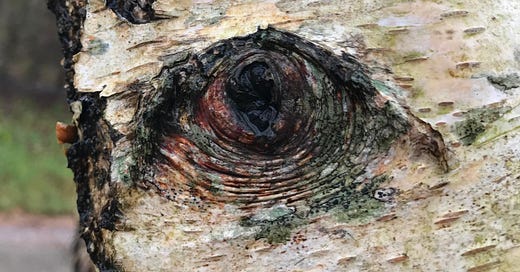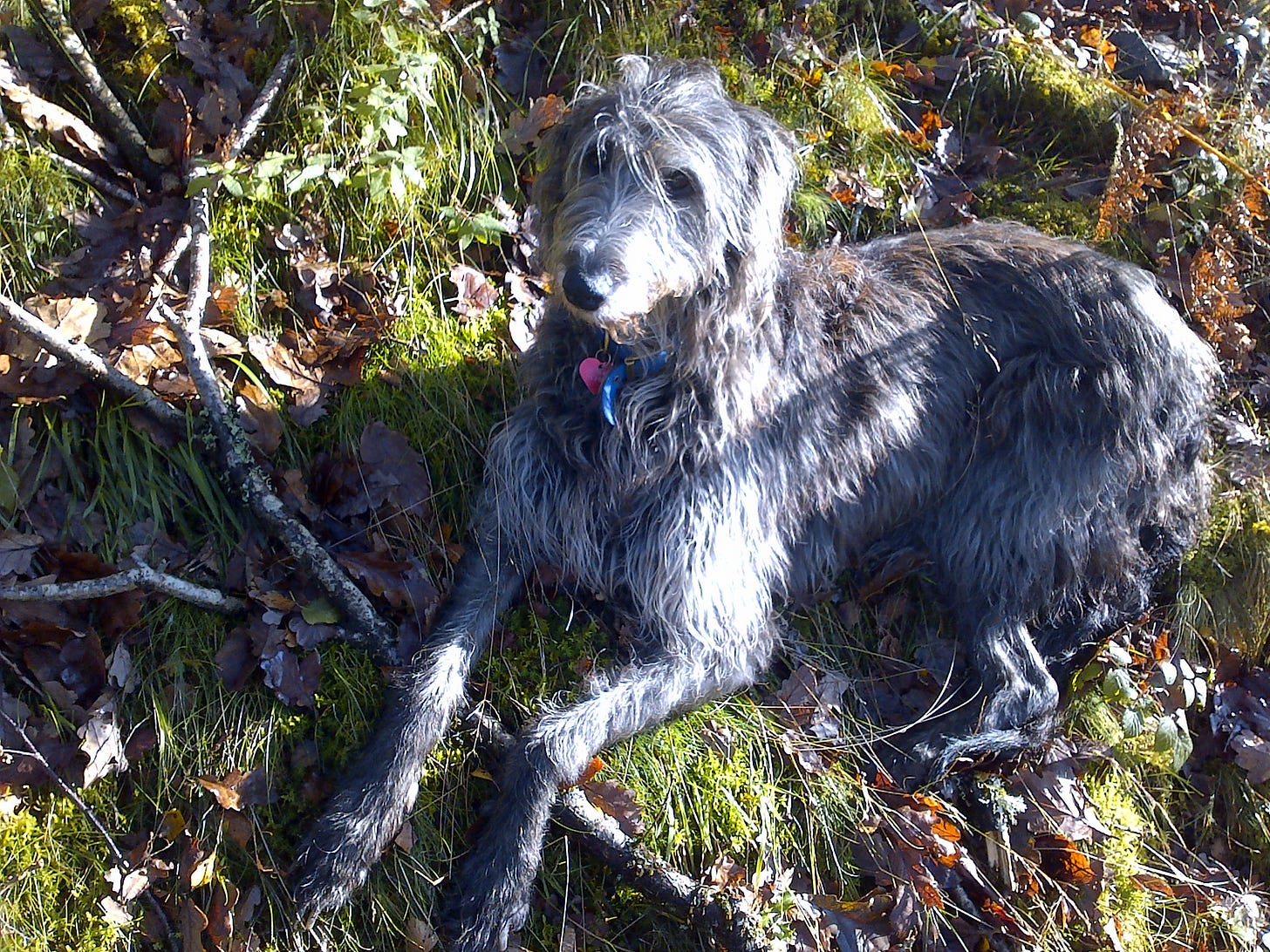Greetings, my friends, previous and new, from this little corner of Brittany where the land is sodden, owls and vixens call at dusk, the stream sings all day and night, and the trees are just yawning and stretching, considering waking up. It being Ash month now in the Celtic Tree Calendar I can once again use that phrase I love, ‘apical helispheres’, to describe the small black hoof-like ready-to-bud tips of the few ash trees hereabouts. Some describe the ash as being the World Tree, don’t they? And how I love the ash in the image above; one of a dozen in-those-days-healthy ash trees forming an avenue in the Devon valley where I’d walk daily with my old dog, also called Ash.
Fronting life deliberately
Henry David Thoreau famously said, when he retreated to live by Walden Pond: ‘I went to the woods because I wished to live deliberately, to front only the essential facts of life, and see if I could not learn what it had to teach…’ And his book Walden is a mix of outer observation, inner musings, and philosophical reflection; the best kind of mix, and of course as relevant now as it ever was. (How many of you have a copy of Walden on your bookshelves? And how many of you have read it right through??)
In his footsteps, of course, have been another 2 or 3 generations of ‘nature writers’, many of them adding a level of deeply personal memoir. There are far too many to mention here, including some truly excellent contemporary writers, but the one who springs to my mind after Thoreau is Annie Dillard, probably because I read her not long after reading Thoreau, and her Pilgrim at Tinker Creek remains a classic of the genre. There are passages from that book that, after decades, I still remember.
I have been thinking about that Thoreau quote since I wrote #42; in that piece I included this:
‘I believe we each come into this world with a soul contract:
– to wake up, to be apprenticed to the work of consciousness
– to be aware of, to realise, the interconnectedness of us all, of everything
– to bring harmony instead of conflict, to live peaceably, to practise compassion and loving kindness and non-harming (in Buddhism, ahimsa or metta)’
and thinking how what we are doing here in the Beautiful Middles of Nowhere is focusing on what it means to live consciously, deliberately, ‘fronting the essential facts of life’, trying very much to work with the land, in harmony, and seeing how to learn what the land has to teach.
I remind myself over and over that the network in which we all, human and other-than-human, live is one of interdependence; we are all leaves of the one tree.
Coppicing
Everywhere at the moment the hazels are dressed in such an abundance of catkins that the land is deep-washed in gold. Many of the hazels in the banks and hedges, as well as in the woodland, both here on the land we tend but also for miles around, were clearly once coppiced, and their branches used for wattle, as in wattle and daub for housing, hurdles and various aspects of fencing, basket-making and poles for growing things (we use them in place of the more common bamboo for our climbing beans).
It’s quite moving to see how many hazels were once, not so long ago, routinely coppiced in such a rural area, and how few are now, with people buying metal and plastic fencing instead (we’re not innocent of that; when we moved in we first fenced about 7 acres of the surrounding meadows so that the dogs were safe from the hunt, and the deer were safe from the dogs, and the little trees we’ve planted were safe from the deer. We hadn’t the time nor the money to do anything else, especially taking on such a big project at this stage of our lives.)
Hazel, of course, is a magical tree too. She has an affinity with water – traditionally her forked twigs were used for dowsing, and I have had some luck with that myself. She’s associated in Celtic lore with the Salmon of Wisdom; nine hazels dropped their nuts into the sacred Pool of Inspiration, to be eaten by that salmon, returned to her birthplace. (You can read my Salmon of Wisdom story here.)
Learning from trees
Although it’s not Hazel month, hazel has been an ally for us here, with her wood, and the possibility of nuts. We’ve planted what we hope is a cobnut (bigger fruits than a wild hazel) in our embryonic forest garden, which now has, in addition to the separate arc of apple and plum trees, another 18 or 19 mixed fruit and nut canopy trees, with one for TM for beauty, blossom for bees, early edible leaves and its health-giving properties as a relaxant and to lower blood pressure (the lime, linden, tilia europea), and one for me for magic (the witch hazel, hamamelis): – I’ve used distilled witch hazel forever for soothing skin problems, for a cleansing tonic for my face, for swollen and bruised places on our or the dogs’ bodies.
We are trying to create, in micro, a project in which we grow food for climate resilience and, if necessary ever, for friends and the local community, without compromising the wellbeing of the more-than-human world in which we are embedded. Our veg garden is large and growing; as much as possible we grow our food with no-dig principles, using mulches from the land, including woodchip as a mulch from the smaller of the many fallen branches and trees, which themselves go to our heating, and we return the ashes to the land.
Everything’s grown veganically, and much of it is moving towards perennial cultivation: probably essential for climate resilience in future. Hence the forest garden: a food area that is transitional between the previously-grazed meadow and the wild wood around us: a deliberately-planted food forest with optimal spacing, a canopy, a second storey of smaller trees and shrubs, and ground cover plants, all mimicking as much as possible natural systems. Although there are many more canopy trees to plant, we’ve also begun a second storey with sea buckthorn (for fruits) and one or two other fruiting shrubs. Many of the trees are also medicinal – let food be your medicine, as Hippocrates wrote.
Plenty more to do. And also on the vegan cookbook I’ve been banging on about for ages: I have a deadline and a rewrite; this blog is a welcome diversion from both that and my annual complicated and demanding re-application for a visa to continue to live here (thank you, Brexit, the gift that keeps on giving).
So back to it; and I’ll leave you here with a February poem from a Somerset wood, and a love, from an extended sequence a long time ago:
from Entering the Wood
February is coppicing
spring-cleaning the wood
remembering line, vaulting, architecture
thinning hazel scrub
to let in summer
when it comes
the pattern of our saws
their dissonant harmonies
weak sun on our backs
thin feather of smoke
and the showers of rufous catkins
around our feet
the mallet’s knock
its echo
on the road the erratic pulse
of traffic
we think of tidying our lives
(in Bardo, © Roselle Angwin, Shearsman Books 2011)
As always, my friends, thank you for reading. I’d love a heart, a comment, a share if you feel so minded.






love this walk with ash an hazel and the extra trees -- tilia is also good medicinally -- it's nervine so relaxant for anxiety and anti-inflammatory and mildly pain relieving and blood pressure lowering too.
‘An abundance of catkins’ just perfect for this budding season… And thank you for your lovely poem, and ‘rufous’ bringing a new word into my life!